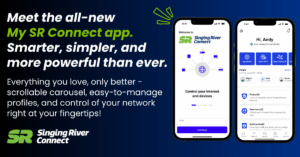National Cybersecurity Awareness Month
October 14, 2022

October is Cybersecurity Awareness Month, a nationally-recognized time to reflect on some of the less pleasant elements of today’s cyber-driven world—and how to protect your devices, network, online accounts, assets, and privacy.
We do more than deliver fast, reliable fiber internet to your home. Every day, our technicians and security specialists work tirelessly to provide your high-speed internet service as safely and securely as possible.
Our best efforts are only most effective when you take necessary precautions to ensure your online security and protect your privacy, too.
So we believe Cybersecurity Awareness Month is an opportune time to share some of our top tips for keeping your home network and devices secure. We’ve compiled some of the best cybersecurity measures from experts worldwide to help you stay safer online.
1. Create and Use Strong Passwords
As basic and simple as it sounds, we cannot stress enough the need to create strong passwords for your online accounts and devices. But unfortunately, far too many people still use the same passwords from years ago (or longer!).
Hackers and other security breaches have compromised numerous online accounts in recent years. That means the password you named after the dog you had in the early 2000s might be in the hands of someone with bad intentions.
Some of the most effective password-creation tips include:
- Using long passwords, preferably at least 8-characters in length
- Never use personal information such as your name, date of birth, hobbies, or your Social Security Number
- Use capital letters and vary their placement (i.e., don’t just use a capital letter at the beginning of your password, but add at least one capital letter at a random position in your password)
- Add symbols and numbers to the words and letters you choose.
Although the tips above are great for creating a personal password yourself, we recommend using a random password generator to create a password that is impossible for anyone (or any hacker’s computer algorithm) to guess.
Random passwords are the most secure and well worth the few minutes of your time to generate and memorize.
2. Utilize a Password Manager
After you’ve created a strong and unique password, your next step toward improving your online security and protecting your privacy is to utilize a password manager. A password manager is a digitally-secure tool to save and guard access to your online accounts.
And when we say “digitally secure,” we mean it. Password managers employ among the highest levels of encryption, so the password you input into the password manager never leaves your device without being encrypted first, making it virtually impossible to steal or hack.
Password managers also use a “master password” for you to access your accounts, greatly reducing the frustration of needing to remember multiple passwords for all your online log-ins. This makes password managers extremely convenient and extra secure!
3. Keep Your Software Updated
Your devices’ operating systems and the apps and programs you run are usually consistently monitored for security weaknesses and threats. Their developers stay on top of these concerns and constantly improve them, filling in breaches and gaps and keeping the software and devices stable and robust.
However, your software only gains these benefits if you keep them updated! And unfortunately, far too few of us even check to ensure we are running the latest and most secure versions of the software that runs our devices and programs.
Many devices and programs contain an auto-update feature or will automatically notify you when there is a software update. Take advantage of these features to stay on top of the latest security measures and improvements of each device, app, and program you regularly use. We offer ProtectIQ which gives users network-level security that protects all devices that are connected to your Wi-Fi. Protect IQ automatically blocks attempted visits to known harmful websites, monitors incoming traffic to keep hackers out, and sends notifications of blocked security threats.
4. Beware of Phishing Scams
Finally, there has been an alarming increase in “phishing” scams.
Phishing is different from ordinary hacking because scammers attempt to lure you into providing your personal information directly to them.
Phishing scammers try to get you to enter your password, home address, Social Security Number, or even your bank account information, any one of which could lead to identity theft, online extortion, ransom, or even theft.
Preying particularly on older individuals, who are more accustomed to solicitation and marketing advances, phishing has become more common and sophisticated. It’s essential to recognize phishing before and during a phishing attempt.
Signs of phishing scams include:
- Emails or text messages indicating “unusual activity” on your account and then asking you to click on a link and follow the instructions—do NOT click on any such link!
- Messages with a lack of any greeting, or only using portions of your email address, using “Sir/Madam” instead of your name, or containing an incorrect spelling of your name
- The email address domain name is misspelled or does not match the company or governmental entity it claims to be
- Urgent time limitations to “act now” are included in the message, often provoking you to respond within one day or even a matter of hours, which attempts to make you “click” without thinking carefully about whether it is a legitimate issue
- Poorly written text and content, clearly demonstrating that the message is not a legitimate business or governmental matter
Implementing these tips will help keep you, your family, and your devices, data, and programs safer and more secure. And always use your common sense—if something does not seem or feel right, do not click or engage.



